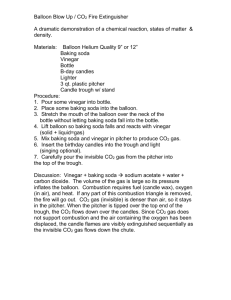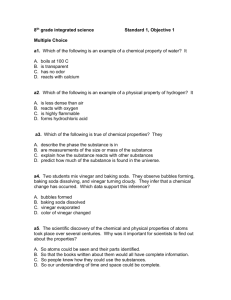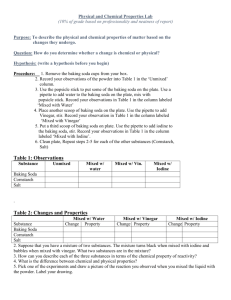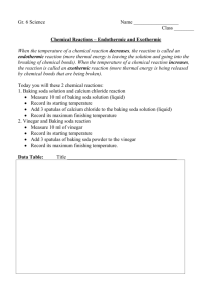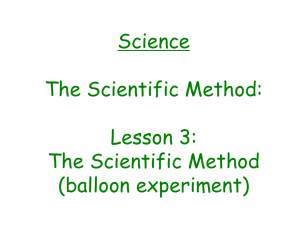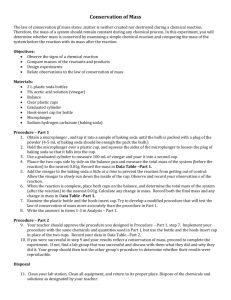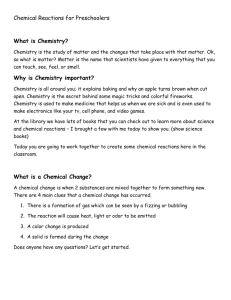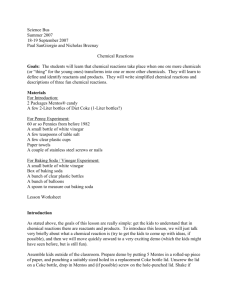EXTRA CREDIT WINTER BREAK ASSIGNMENT Instructions: Email
advertisement
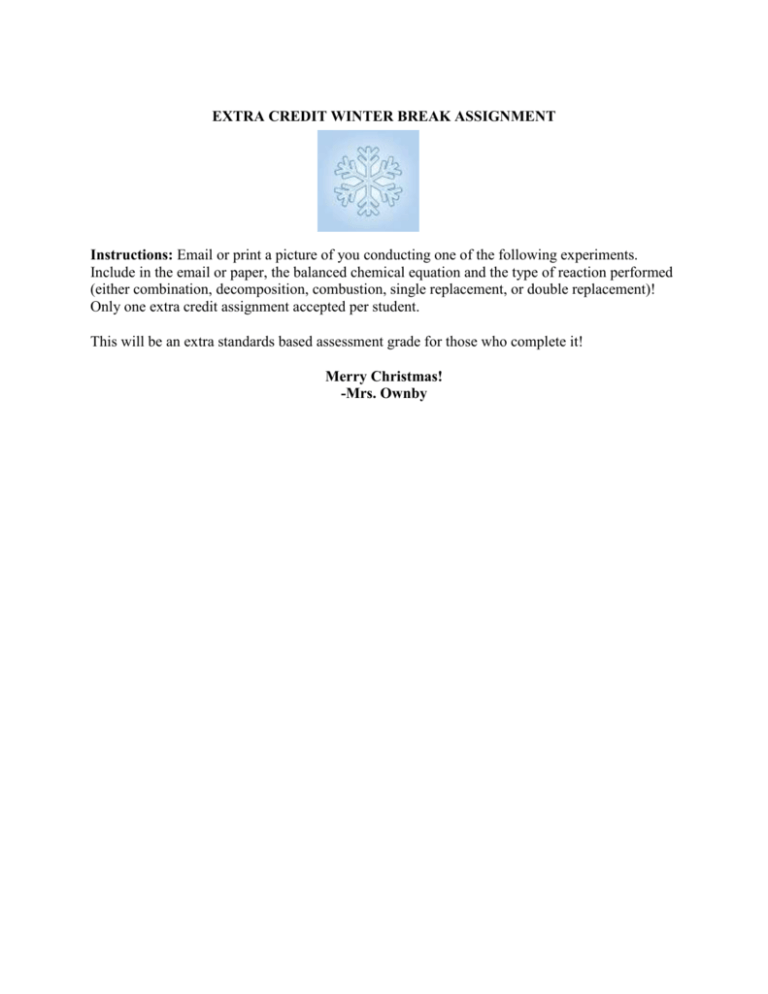
EXTRA CREDIT WINTER BREAK ASSIGNMENT Instructions: Email or print a picture of you conducting one of the following experiments. Include in the email or paper, the balanced chemical equation and the type of reaction performed (either combination, decomposition, combustion, single replacement, or double replacement)! Only one extra credit assignment accepted per student. This will be an extra standards based assessment grade for those who complete it! Merry Christmas! -Mrs. Ownby Invisible Ink What You Need: Baking Soda (NaHCO3) Paper Water Light Bulb (heat source) Paintbrush or Swab Measuring Cup Purple Grape Juice (opt.) Here's How: 1. There are at least two methods to use baking soda as an invisible ink. Mix equal parts water and baking soda. 2. Use a cotton swab, toothpick, or paintbrush to write a message onto white paper, using the baking soda solution as 'ink'. 3. Allow the ink to dry. 4. One way to read the message is to hold the paper up to a heat source, such as a light bulb. The baking soda will cause the writing in the paper to turn brown. 5. A second method to read the message is to paint over the paper with purple grape juice. The message will appear in a different color. Tips: 1. If you are using the heating method, avoid igniting the paper - don't use a halogen bulb. 2. Baking soda and grape juice react with each other in an acid-base reaction, producing a color change in the paper. 3. The baking soda mixture can also be used more diluted, with one part baking soda to two parts water. 4. Grape juice concentrate results in a more visible color change than regular grape juice. Chemical Equation: Type of reaction: ? NaHCO3 NaOH + CO2 Foam Fountain What You Need: empty compressible plastic bottle - no lids water diswashing detergent baking soda vinegar food coloring (optional) Here's How: 1. First, you need a plastic bottle (2 L bottle or Gatorade bottle work best). 2. Fill each bottle most of the way full of warm water and add a squirt of dishwashing detergent. 3. Add some baking soda to the bottle (couple of tablespoons or so). Put your hand over the bottle opening and shake it up to get the detergent water all sudsy. Drip a bit of food coloring onto the suds. 4. Note: if you add the food coloring before shaking the detergent water, then the dye will go into the water and the bubbles will be clear. If you add the coloring just prior to adding the vinegar then the bubbles will be deeply colored (which also increases the staining potential). 5. Pour in some vinegar. This starts the reaction. Feel free to give the bottle a little squeeze to help things along. Do NOT seal the bottle with a cap or lid. That basically makes a baking soda bomb, which is dangerous. Tips: 1. It's messy, so you might want to do this project outdoors or in a bathroom 2. Be Advised!!! adding food coloring could result in staining of clothing and other surfaces! 3. Avoid getting the mixture into your eyes or mouth. If eye contact occurs, rinse the solution out. Don't drink the contents of the bottle. 4. Avoid contact with unreacted vinegar or undiluted dishwashing detergent. Both can irritate skin and mucous membranes. Chemical Reaction: C2H4O2 (vinegar) + NaHCO3 (baking soda)---> NaC2H3O2 + H2CO3 That last product is carbonic acid which turns into carbon dioxide and water: H2CO3 ---> H2O + CO2 (foam) Balance: No balancing required! Therefore, give the type of reaction for both reactions taking place Types of Reactions: C2H4O2 + NaHCO3 ---> NaC2H3O2 + H2CO3 H2CO3 ---> H2O + CO2 Pretty Pennies What you need: Dirty pennies White vinegar Table salt Shallow glass or plastic bowl How to: 1. 2. 3. 4. 5. Put a couple of your dull, dirty pennies in the bowl. Cover the pennies with salt. Pour white vinegar over the pennies. Rub the salt and vinegar mix over both sides of the pennies. Take the pennies out and wash off the salt and vinegar mix. What do you see? The pennies should be much shinier. Chemical Reaction: C2H4O2 (vinegar) +CuO (dirty pennies)⟶Cu(C2H3O2)2 (clean pennies) +H2O Balance: C2H4O2 + CuO Cu(C2H3O2)2 + H2O Type of Reaction: ? Melting Styrofoam *Another fun experiment you can do at home! This is an experiment where Styrofoam is dissolved in water, and therefore, no chemical reaction actually takes place. Therefore, there is no chemical equation for it and you cannot balance it or give the type of reaction. This experiment is just for fun, not extra credit! : ) * Materials: Acetone (nail polish remover) Styrofoam cups Metal bowl or pot Experimental Procedure: WARNING: Please follow the manufacturer's warnings on the container of acetone. Only adults should use acetone. The solvent is very flammable and harmful if inhaled in large quantities, so conduct this experiment outside or in a well-ventilated area! 1. Pour ½ cup of acetone into the bowl. 2. Slowly lower a Styrofoam cup into the acetone. Observe the reaction between the acetone and the Styrofoam. 3. See what happens when you put more than one cup into the acetone at the same time. Tips: 1. The styrofoam can be disposed of in the trash and the nail polish remover can be put down the sink. 2. The goo is fun to play with! Do not ingest it and be sure to wash your hands when you are finished. *To watch some even cooler experiments, search STEVE SPANGLER on YouTube! *

